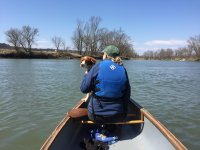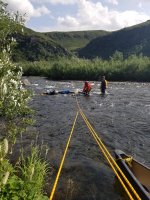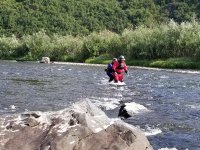I have taken many, many swims. The vast majority of these have been on whitewater rivers but I have managed to fall out of canoes on flat water and easy Class I rivers at least three times that I can recall. None of my swims have been preserved on film or photographs, thank God. The majority of swims I have taken have been relatively brief without much threat to life or limb and in at least 95% of cases I self-rescued without losing boat or paddle. But I have lost a few nice fleece tops, gloves, and shoes that were poorly secured. For some reason when I loose gloves or shoes it is always the right-hand one.
Three swims I took on whitewater were very memorable and potentially life-threatening and in each case I had no assistance available. I will relate each in a separate post since the descriptions are somewhat long.
Whitewater paddlers in the Southeast will undoubtedly be familiar with the Hiwassee River. It is frequently used as a training river for beginning whitewater paddlers and is usually a pretty tame Class II-II+ dam release 5 mile run. Far less well known is the portion of the river just upstream of the powerhouse that releases at the top of that run. That is because the stream bed is nearly always completely de-watered. The TVA diverts water from the "dries of the Hiwassee" through a very large pipe conduit that can nearly always handle all the flow mother nature can provide. So when the "dries" are runnable the water level will nearly always be different one time to another, so paddler experience can be highly variable for those few who have run it. It only stays up for a day or two, so it is very much a catch as catch can run. Another feature is that whenever the river does run, water is flowing very briskly through mature trees at the sides of the river, and there are even saplings growing in the middle of the stream bed in places.
I used to paddle with a friend in Tennessee who long ago died of heart disease. He had had a wild hair to run the dries for a long time and had solicited advice and info from a handful of people who had run it. Unfortunately, the assessments varied widely, partly as a result of different levels of paddler expertise, but largely due to the fact that the natural discharge had undoubtedly varied greatly for the various different runs. Assessments varied from "don't bother, its not worth the trouble" to "stay away, it is a death trap". Advice on possible put-ins and how to reach them was also highly variable. The only thing that everybody agreed on was that there was one rapid called "Hollywood Bowl" that was a mandatory portage, but nobody agreed on exactly how far into the run it was situated, probably because different groups had put on at different locations.
My friend undaunted, bided his time and waited for one of the rare opportunities to run the dries. He shall remain nameless since he is no longer around to protect his reputation but I will call him "Dave". When the opportunity came, Dave quickly recruited me and another paddler named Jack Wright, all of us paddling open boats. Dave picked his companions with care. He chose me for my stupidity, knowing I was dumb enough to go along with his scheme. He chose Jack for his paddling expertise since Jack had been one of the group of pioneers that first paddled the Gauley River in West Virginia in hard boats after the construction of Summersville Dam in 1968. Jack Wright had later paddled the Gauley in open boats and I believe he is credited as being the first paddler to do so.
Although the put-in location was as unclear as the route to get to it, the take out options were obvious. The smart thing to do would have been to park vehicles at the powerhouse above the usual 5 mile run. Of course, this is not what we elected to do. Whenever the dries of the Hiwassee has enough water to run, the lower section is ripping and easily rates a Class III+. But we had all run that stretch many times and felt pretty comfortable paddling it at high water so we left cars at the bottom of the 5 mile stretch at Reliance, TN. Of course, nobody was paddling that 5 mile stretch on this particular day. We were totally on our own.
We made a number of wrong turns searching for the put-in that Dave had decided on, so by the time we got going it was much later in the day than we had hoped. Needless to say, we had no support, and no possibility of help with rescues down stream, apart from the three of us. Since Dave had organized this particular debacle, I guess he felt responsible enough to take the lead as we started the run. I followed him and Jack Wright, in his considerable wisdom, chose to follow at a bit of a distance behind the two probes ahead of him. The going was initially quite easy with only a few straightforward Class II rapids, but we were all a little on edge not knowing just where we would come across Hollywood Bowl. Suddenly Dave, who was about 25 yards ahead of me, gesticulated frantically toward the river right bank and started paddling in that direction for all he was worth. About 10 yards before he made it, he dropped out of sight over a horizon line that I had failed to appreciate up until that point. I had enough warning and distance that I am pretty sure I could have reached the right bank which would have been the intelligent option. So I passed on that, imagining that I could do a "fly by" near the edge of the drop, getting close enough to see over the edge before swinging the boat upstream and executing a strong forward ferry. I got close enough to see that Dave and his canoe had gone over a roughly 6 foot drop and he and his boat were now stuck in a big hole. I realized that the current was probably too strong for me to reach the right bank anyway and so quickly came up with a ridiculous plan to try to knock Dave and his boat out of the hole. Predictably this resulted in two paddlers and two boats stuck in the same hole. Dave came out of his boat and was ejected from the hole but his canoe stayed in and was getting tumbled. Dave was able to hold onto his paddle. I did not stay in my boat much longer and found myself swimming in the hole along with two canoes which were getting tumbled. I took some solace in the knowledge that the hole was not a keeper, since it had spit Dave out, but I was reluctant to let go of the canoes because there was no hope of downstream rescue. The canoes had enough flotation that they seemed reluctant to be spit out anytime soon. I figured that if I could hold onto the painters long enough that either I or one of the canoes would eventually exit the hole and drag out what remained, assuming I could hold on. But I had a difficult decision to make. It would have been much easier to hang onto my boat and let Dave's go rather than try to swim and self rescue with two swamped canoes. But that would have condemned Dave to a long walk out and probably a lost boat, and it did not seem Kosher to hang onto my boat and let go of his. And I wasn't going to let go of my (actually my wife's) relatively new canoe.
Well eventually the two boats and me did get out of the hole, but I don't recall the exact sequence of exit. But the 6 foot drop was just the beginning of this "mandatory portage" rapid. There were multiple other smaller but substantial drops and holes that followed. I hung on for dear life and tried to stay upstream of the boats. But I was now swimming with two waterlogged canoes a river that I had never paddled or scouted, that was flowing briskly through trees along both banks. It was very difficult to see downstream far enough to spot a location at which I could safely get the boats through the tree maze over to the bank and still have time to execute that maneuver. So I went downstream a good ways, over a mile, before I was able to get myself and the boats out of the current. I then lay on the bank and vomited a number of times.
Meanwhile, Jack Wright observing what had happened reached the right bank and took out. My friend Dave, unencumbered by boats, was able to swim to the right bank a short distance below Hollywood Bowl, although he was a bit shaken up from the swim. Both he and Jack had to climb a fairly steep bank to some train tracks, Jack dragging his canoe along with him. They then had to make their way a good distance down the tracks to rendezvous with me. By the time they did so it was already pretty late in the day.
We knew that if we didn't hurry it would be dark before we got to the powerhouse. None of us were eager to run the lower Hiwassee in the dark at its present level but none of us really wanted to walk the 5 miles from the powerhouse to the cars either. But we were now all rather spooked and at least Dave and I were rather spent. So we wound up scouting just about every rapid we couldn't see the bottom of from the water, and portaged a couple that we would have run under other circumstances. So by the time we got to the powerhouse is was really, really dark and we still had a five mile paddle in high water to get to the cars. The paddle was memorable, and thank goodness nobody swam. We could not see the rapids until we were on them even going as slowly as we could, and could only identify their locations by sound. But we were familiar with all of them and their sequence, which saved us. We made that 5 mile run in 45 minutes, well over a 6.5 mph pace, going as slowly as we could manage.
I don't believe Jack Wright ever paddled with us again after that experience.












